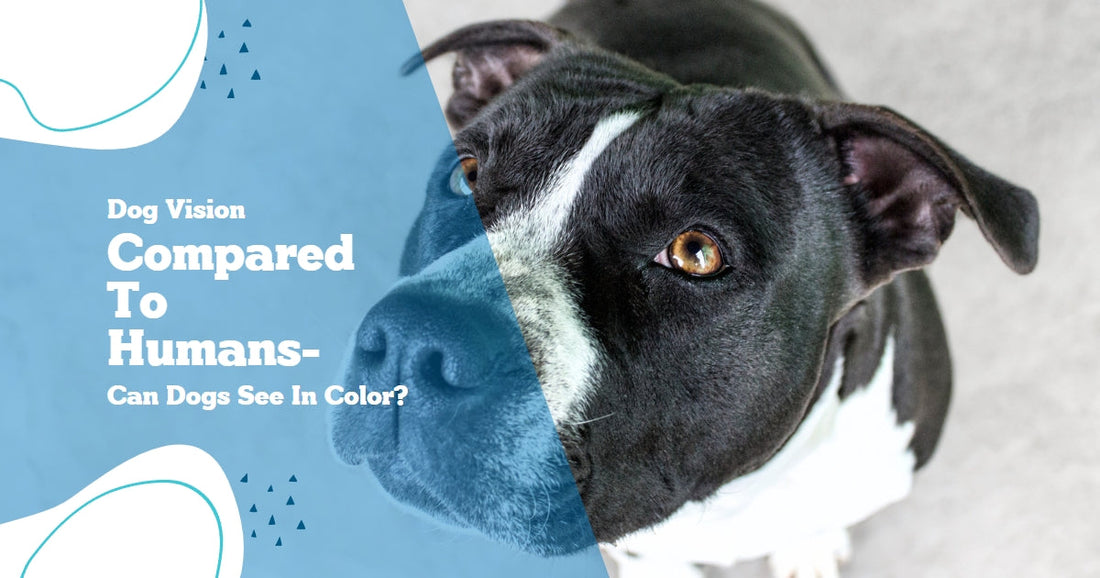For years, experts believed that dogs saw the world entirely in black and white. But recent studies have shown that while dogs don't see colors the same way humans do, they can still see some colors.
Although dogs don't understand the complexities of colors, extensive research has shown that they can see more than just shades of grey.
What Is Color Blindness?
In the late 18th century, English scientist John Dalton conducted some of the first studies on congenital color blindness. Dalton learned about the phenomenon when he and his brother realized they could not see some colors. They would mix up scarlet with green or pink with blue.
The most common form of color deficiency in humans is red-green color blindness, which affects up to 8 percent of men and 0.5 percent of women with Northern European ancestry. Abnormalities in color-detecting molecules, known as cones, cause it. The retina is a lining at the back of the eye that converts light into electrical impulses. These signals are then conveyed to the brain through the optic nerve where an image is formed.
People who are missing certain color-detecting molecules (photoreceptors) won't be able to see some colors. This is what makes them colorblind, although they can usually still see other hues. Red-green color blindness affects a person's ability to see certain colors. While those with the condition can still perceive yellow and blue, red instead appears gray or brown.
Myths About Dogs Seeing Colors
The idea that dogs see the world only in black and white has been credited to Will Judy, a lifelong dog lover, writer, and former publisher of Dog Week magazine. He claimed to be the first person to declare that dogs had poor vision and thought they could only see single shades and tones, with general outlines and shapes as their only perception of the world.

“It’s likely that all the external world appears to them as varying highlights of black and gray,” Judy wrote in his 1937 manual, “Training the Dog.”
Although researchers in the 1960s hypothesized that only primates can see color, there was little evidence to support their theory. This assertion--that dogs are colorblind--soon became accepted as fact, even though there wasn't much research to back it up.
Are Dogs Color Blind or Spectrum Challenged?
Recently, investigations of a dogs eye structures have shown some crucial design dissimilarities between human and canine eyes. Evolution and function drove these developments. Dogs honed their senses as night hunters, often needing to track and capture prey in the dark hours. Therefore, over time their eyes adapted to see better in low light and catch movement more effectively.
Canine eyes are better equipped for hunting at night because they have a larger lens and corneal surface, as well as a reflective membrane called a tapetum that enhances night vision. They also have more rods in the retina, which improves low-light vision.
The retina is not only responsible for color perception, but also the key difference in how dogs and people see colors. The retina is made up of millions of light-sensing cells, which include:

- Rods are sensitive cells that pick up movement and work best in dim lighting.
- These cones work to help you see in bright light and accurately perceive color.
The reason dogs see a limited number of colors is because they have more rods than cones in their retina, while humans have more cones. Trichromatic is when an organism has three types of cones, and humans are one of the few primate species that have this trait. on the other hand, dogs only have two types of cones and are considered dichromatic.
Different types of cones perceive different light wavelengths. The one for red and green enables humans to see a rose's color or the green of an apple. Dogs, and some people with color blindness, are missing red-green cones.
Some fish and birds can see a broader range of colors than people. Many birds and fish are tetrachromatic, meaning they have four types of cone receptors to absorb ultraviolet light.
Different-Colored Dog Toys Through the Lens of a Dog

Left: Human view of a brown Labrador Retriever carrying an orange frisbee. Right: The same scene through canine eyes is interpreted through the knowledge we now have.

Left: Human view of an Australian Sheppard carrying a red toy. Right: The same scene through canine eyes is interpreted through the knowledge we now have.

Left: Human view of a Jack Russell laying by a red toy and colorful toy that includes blue and yellow. Right: The same scene through canine eyes is interpreted through the knowledge we now have. As you can see the blue and yellow stand out more against the ground.
So, Can Dogs See Colors Like We Can?
A dog's color vision is thought to be similar to that of a human with red-green color blindness.
While people see a world with many colors, dogs only perceive yellow and blue. This makes most of the world appear grayish-brown to them. For example, that beautiful green lawn looks like dead hay, and that bright red velvet cushion appears as a dark brown blob.
What Does This Mean to You and Your Dog?
Since dogs can't see certain colors, it would be beneficial to get them products that feature the colors they CAN see. For example, this might explain why some dogs are obsessed with yellow tennis balls but could care less about pink or red ones.
If you're playing fetch with your dog and don't want him to lose the ball in the grass or lake, choose a color other than red. Also, when teaching your dog to differentiate between two toys or obedience training dumbells, it would be helpful if one were blue and the other yellow.

The most popular colors for dog toys today are red or orange. However red and orange are difficult for dogs to see. This causes them to run right past the toy that you tossed, but it does not mean they are stubborn or stupid. The color you picked for your toy may make it hard to find against the green of your lawn.
Can Dogs See in the Dark?
Dogs have superior vision in the dark due to their unique eye anatomy when compared to humans.
Because they have more rods in their retina, dogs are better at motion and light detection than humans. With this enhanced ability, dogs can react to small movements and sense when strangers or prey is nearby.
Much like other predators, dogs have a reflective membrane in the back of their eyes.
This membrane reflects light that rods haven't absorbed back to the retina. This allows eyes to take in more light, improves nighttime vision, and makes it look as if dogs’ eyes glow in low-light situations.

Breed May Affect What Dogs Can See
Depending on the breed of dog, their field of vision can differ drastically.
For example, Borzois have a long and narrow face which gives them sharp peripheral vision but they can't focus as well on objects in front of them. On the other hand, Pekingese have shorter faces giving them wider areas they can take things in with both eyes (binocular vision), but their blind spot is much larger.
We can never see the world as dogs do, but we can apply what we know about the canine vision to help solve mysteries and illnesses in human eyes.
Research on blindness in dogs has, remarkably, assisted medical professionals in comprehending and treating blindness in children.

By understanding your dog's vision, you will be able to provide a higher quality of care and have greater empathy for him. This exercise in imagination will pay off dividends in the relationship you share with your furry friend.












